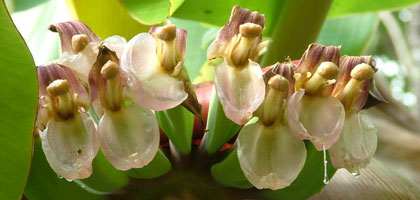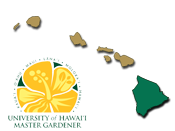
Fruit Fly Suppression...Easy as 1-2-3
#1 Field Sanitation
What is sanitation?
Sanitation is the disposal of infested fruit so that fruit fly eggs and larvae do not survive. It is an important suppression method for two reasons: 1) Infested fruit may hold hundreds of larvae and/or eggs; by getting rid of that one fruit, you are eliminating future fruit fly swarms. 2) Pesticides applied to fruit do not kill larvae and eggs.
What are some sanitation practices I could use?
- Compost: Make sure the compost pile is covered and working (generating internal heat levels in excess of 140 ° F.)
- Animal Feed: Avoid leaving fruit on the ground for more than a day.
- Drowning: Place infected fruit under water for at least 48 hours. Fruit can become re-infested after treatment so you must dispose of it in some way.
- Bagging: When bagging fruit in plastic bags, make sure the opening is sealed tightly and there are no holes in the bags. Larvae can wiggle through very small spaces. After 1 month all the fruit fly larvae in the bags will have died, and the organic waste can be dumped in the field for green manure.
- Grinding: Mechanically destroying larvae requires a mechanical process such as a garbage disposal. Crushing or smashing the fruit is not an effective way to kill larvae.
- Burying: Larvae have been known to burrow 18 inches to the surface in loose soil. Therefore, if you bury infested fruit, make sure that it is buried at least 18 inches deep.
#2 Protein Bait
What is Protein Bait and how does it work?
Fruit flies need sugar for energy and protein to mature and reproduce. Protein baits attract and poison feeding male and female fruit flies.
The baits are detected by fruit flies over short distances (10-20 ft.) Some of the commercial protein baits are combined with other volatile odors that attract the flies from slightly greater distances. Fruit flies attracted to the protein bait are killed by drowning in the protein slurry or by the toxicant.
What are some protein baits currently available?
GF-120, a spinosad protein bait, became commercially available in June 2002. It can be purchased from larger fertilizer and pesticide dealerships and from the Master Gardeners. GF-120 attracts multiple fruit fly species, both male and female. It is active for at least 10 days after initial application and can be stored for up to 2 years without degradation. See CTAHR's publication "Managing Fruit Flies on Farms in Hawaii" for more control methods.
How do I apply GF-120 protein bait?
GF-120 is designed for low volume and low toxicity application. The recommended ratio of GF-120 to water is 1:2, or 1:3, not to exceed 1:4 ratio. As always, read the label prior to application. Follow safety precautions and applicable use directions. Spray GF-120 on the undersides of leaves of host fruit trees or paint GF-120 on the inside of a coffee can/plant pot and hang upside down from a branch.
Where do I spray the bait?
Melon Fly: Spot spray protein bait in crop borders, on or near a roosting host.
Oriental Fruit Fly: Spot spray protein bait in or around approved fruit trees.
Mediterranean Fruit Fly: Spot spray protein bait in or around approved fruit trees.
Protein bait works best when applied to the underside of leaves.
When do I apply the protein bait, and how often?
Protein bait works best when applied at a 7-14 day interval. Growers who plant crops periodically may apply protein bait before the flowering stage to suppress the fruit fly populations before fruiting. For year round gardeners / those who maintain continuous hosts throughout the year, apply protein bait at 7-14 day intervals on approved crops year round.
#3 Trapping
Fruit fly traps using male lures reduce the number of fruit flies in your garden area. There are three keys to successful trapping:
- Use the correct lure
- Good trap placement
- Timely trap maintenance
Use of fruit fly lures, if used in conjunction with sanitation and protein bait, will reduce fruit fly populations due to the lack of males available for mating.
What kind of lure do I need?
Melon Fly: Major Hosts are bittermelon, cucumber, eggplant, melon, pepper, pumpkin, sequa, squash, tomato, and zucchini. Other Hosts are gourds, guava, ivy gourd, papaya, strawberry guava, spiny cucumber, and wild bittermelon.

Melon Flies are common at sea level to 1500 foot elevation. Note black spots at wing tips in photo.
Oriental Fruit Fly: Major Hosts are breadfruit, carambola (starfruit), cherimoya, citrus, guava, mango, papaya, and peach. Other Hosts are apricot, banana, calamondin, custard apple, fig, grapefruit, jackfruit, lemon, lime, loquat, kumquat, mountain apple, nectarine, passion fruit, persimmon, plum, poha, sapodilla, and soursop.

Oriental Fruit Flies are common at sea level to 4000 feet. Clear wings.
Mediterranean Fruit Fly: Major Hosts are coffee, citrus, loquat, persimmon, guava, papaya, and peach. Other Hosts are apple, apricot, avocado, bell pepper, carambola (starfruit), date, fig, grape, lychee, mango, nectarine, pear, plum, pomegranate, quince, sapote, Surinam cherry, and tomato.

Mediterranean Fruit Flies are found at high elevations of 1000 to 4000 feet. Note the “picture wings” (brown-yellow bands on the wings.)
How many traps do I need?
- Cue Lure: Melon Fly. Use 2-3 traps/acre or 1-3 traps per backyard*
- Methyl Eugenol: Oriental Fruit Fly. Use 3-5 traps/acre or 1-3 per backyard*
- Trimedlure: Mediterranean Fruit Fly. Use 3-5 traps/acre or 1-3 per backyard*
- Latilure: Solanaceous Fruit Fly (Not available)
*Use fewer traps in combination with protein baiting. Use more traps if lures alone are used.
Trap Placement and Maintenance
Melon Fly: Hang traps at eye level in semi-shade in roosting hosts planted around your crops. Lures should be replaced every 6 months (though they may last longer.)
Oriental Fruit Fly: Hang traps as high as possible in semi-shade in or near fruit trees. Lures should be replaced every 3-4 months (though they may last longer.)
Mediterranean Fruit Fly: Hang traps at eye level in semi-shade in or near fruit trees. Lures should be replaced every 2-3 months (though they may last longer.)
How to Make Your Own Trap
Traps can be made from plastic water or soda bottles. Use the following guidelines to make your own trap:
- Cut bottle in half crosswise, just above the top of the label, so that both sides of the bottle have the same diameter. Discard the bottle cap.
- Use latex gloves or a small plastic bag to keep your hands from touching the lure when you unwrap it. Attach the fruit fly lure plug to one end of a 12 inch sturdy but flexible 16-gauge galvanized utility wire. You can simply hook it on the wire, or put the lure in a plastic basket or bit of mesh cloth.
- Drill a 1/8 inch to 1/16 inch hole through the center of the bottom piece of the bottle. Insert the wire through the hole so that the lure hangs on the inside of the cut bottle. The wire sticking out of the bottle will be used for hanging the trap.
- With the bottom held upside down, insert the top of the bottle into it, with the bottle mouth facing upward. Be sure that the lure does not block the bottle opening.
- Hang the trap in semi shade out of reach of children and animals according to the instructions given above.
- Remove dead fruit flies from the trap by separating the two pieces of bottle and rinsing.
See “Managing Fruit Flies on Farms in Hawaii” under CTAHR Publications.
Submitted by Kendal Lyon, Hawaii Island Master Gardeners
Photo credit: Patty Anger


